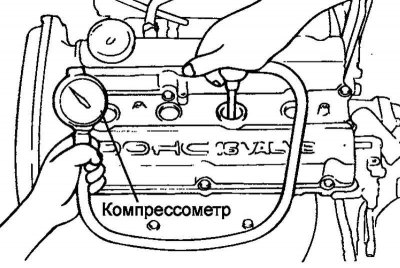Start the engine and warm it up to a coolant temperature of 80-95°C.
Stop the engine. Disconnect high voltage spark plug wires.
Remove the spark plugs.
Turn the engine crankshaft with a starter to remove foreign particles from the cylinders.

Pic. 2.7. Installation of a compression gauge
Install a compression gauge in the spark plug hole (pic. 2.7).
Depress the accelerator pedal until the throttle is fully open.
Turn the engine crankshaft with a starter and read the compression gauge readings.
Rated value: 1200 kPa.
Minimum allowable value: 1180 kPa.
Repeat the measurement for all remaining cylinders and make sure that the compression difference between the cylinders is less than the limit value.
Maximum admissible value: no more than 100 kPa.
If the compression in any cylinder is out of range, or the difference in compression between the cylinders exceeds the maximum allowable value, pour a little engine oil into the spark plug hole of that cylinder and repeat the measurement.
If, after filling with oil, the compression has increased, then the causes of the malfunction are wear or damage to the piston ring and / or cylinder mirror.
If the compression does not increase after filling with oil, then the causes are burnt or damaged valve seats, or gas leaks (pressure) through the cylinder head gasket.
Spark plug torque: 20–30 Nm.
